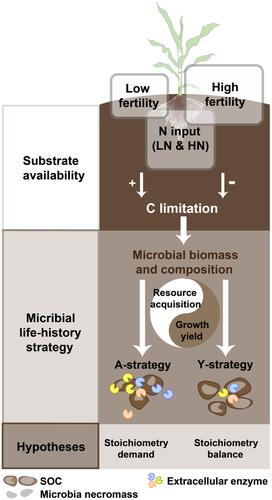当前位置:
X-MOL 学术
›
Glob. Change Biol.
›
论文详情
Our official English website, www.x-mol.net, welcomes your
feedback! (Note: you will need to create a separate account there.)
Microbial life‐history strategies mediate microbial carbon pump efficacy in response to N management depending on stoichiometry of microbial demand
Global Change Biology ( IF 10.8 ) Pub Date : 2024-05-14 , DOI: 10.1111/gcb.17311 Liyang Yang 1 , Alberto Canarini 2 , Wushuai Zhang 3 , Ming Lang 3 , Yuanxue Chen 4 , Zhenling Cui 1 , Yakov Kuzyakov 5 , Andreas Richter 2 , Xinping Chen 3 , Fusuo Zhang 1 , Jing Tian 1
Global Change Biology ( IF 10.8 ) Pub Date : 2024-05-14 , DOI: 10.1111/gcb.17311 Liyang Yang 1 , Alberto Canarini 2 , Wushuai Zhang 3 , Ming Lang 3 , Yuanxue Chen 4 , Zhenling Cui 1 , Yakov Kuzyakov 5 , Andreas Richter 2 , Xinping Chen 3 , Fusuo Zhang 1 , Jing Tian 1
Affiliation

|
The soil microbial carbon pump (MCP) is increasingly acknowledged as being directly linked to soil organic carbon (SOC) accumulation and stability. Given the close coupling of carbon (C) and nitrogen (N) cycles and the constraints imposed by their stoichiometry on microbial growth, N addition might affect microbial growth strategies with potential consequences for necromass formation and carbon stability. However, this topic remains largely unexplored. Based on two multi‐level N fertilizer experiments over 10 years in two soils with contrasting soil fertility located in the North (Cambisol, carbon‐poor) and Southwest (Luvisol, carbon‐rich), we hypothesized that different resource demands of microorganism elicit a trade‐off in microbial growth potential (Y‐strategy) and resource‐acquisition (A‐strategy) in response to N addition, and consequently on necromass formation and soil carbon stability. We combined measurements of necromass metrics (MCP efficacy) and soil carbon stability (chemical composition and mineral associated organic carbon) with potential changes in microbial life history strategies (assessed via soil metagenomes and enzymatic activity analyses). The contribution of microbial necromass to SOC decreased with N addition in the Cambisol, but increased in the Luvisol. Soil microbial life strategies displayed two distinct responses in two soils after N amendment: shift toward A‐strategy (Cambisol) or Y‐strategy (Luvisol). These divergent responses are owing to the stoichiometric imbalance between microbial demands and resource availability for C and N, which presented very distinct patterns in the two soils. The partial correlation analysis further confirmed that high N addition aggravated stoichiometric carbon demand, shifting the microbial community strategy toward resource‐acquisition which reduced carbon stability in Cambisol. In contrast, the microbial Y‐strategy had the positive direct effect on MCP efficacy in Luvisol, which greatly enhanced carbon stability. Such findings provide mechanistic insights into the stoichiometric regulation of MCP efficacy, and how this is mediated by site‐specific trade‐offs in microbial life strategies, which contribute to improving our comprehension of soil microbial C sequestration and potential optimization of agricultural N management.
中文翻译:

微生物生命史策略根据微生物需求的化学计量调节微生物碳泵功效以响应氮管理
人们越来越认识到土壤微生物碳泵(MCP)与土壤有机碳(SOC)积累和稳定性直接相关。鉴于碳(C)和氮(N)循环的紧密耦合以及它们的化学计量对微生物生长施加的限制,氮的添加可能会影响微生物的生长策略,从而对坏死物形成和碳稳定性产生潜在影响。然而,这个话题在很大程度上仍未得到探索。基于 10 年来在北部(Cambisol,贫碳)和西南部(Luvisol,富碳)两种土壤中进行的两次多水平氮肥实验,我们假设微生物的不同资源需求会引起不同的土壤肥力。微生物生长潜力(Y 策略)和资源获取(A 策略)响应氮添加的权衡,从而影响坏死物的形成和土壤碳稳定性。我们将死灵质量指标(MCP 功效)和土壤碳稳定性(化学成分和矿物相关有机碳)的测量与微生物生活史策略的潜在变化(通过土壤宏基因组和酶活性分析评估)结合起来。微生物坏死物对 SOC 的贡献随着 Cambisol 中 N 的添加而减少,但在 Luvisol 中增加。氮修正后,两种土壤中的土壤微生物生命策略显示出两种不同的反应:转向 A 策略 (Cambisol) 或 Y 策略 (Luvisol)。这些不同的反应是由于微生物需求与碳和氮资源可用性之间的化学计量不平衡造成的,这在两种土壤中呈现出非常不同的模式。 偏相关分析进一步证实,高氮添加加剧了化学计量碳需求,使微生物群落策略转向资源获取,从而降低了坎比索的碳稳定性。相比之下,微生物 Y 策略对 Luvisol 中的 MCP 功效具有积极的直接影响,从而大大增强了碳稳定性。这些发现为MCP功效的化学计量调节以及其如何通过微生物生命策略中的特定地点权衡来介导提供了机制见解,这有助于提高我们对土壤微生物碳封存和农业氮管理的潜在优化的理解。
更新日期:2024-05-14
中文翻译:

微生物生命史策略根据微生物需求的化学计量调节微生物碳泵功效以响应氮管理
人们越来越认识到土壤微生物碳泵(MCP)与土壤有机碳(SOC)积累和稳定性直接相关。鉴于碳(C)和氮(N)循环的紧密耦合以及它们的化学计量对微生物生长施加的限制,氮的添加可能会影响微生物的生长策略,从而对坏死物形成和碳稳定性产生潜在影响。然而,这个话题在很大程度上仍未得到探索。基于 10 年来在北部(Cambisol,贫碳)和西南部(Luvisol,富碳)两种土壤中进行的两次多水平氮肥实验,我们假设微生物的不同资源需求会引起不同的土壤肥力。微生物生长潜力(Y 策略)和资源获取(A 策略)响应氮添加的权衡,从而影响坏死物的形成和土壤碳稳定性。我们将死灵质量指标(MCP 功效)和土壤碳稳定性(化学成分和矿物相关有机碳)的测量与微生物生活史策略的潜在变化(通过土壤宏基因组和酶活性分析评估)结合起来。微生物坏死物对 SOC 的贡献随着 Cambisol 中 N 的添加而减少,但在 Luvisol 中增加。氮修正后,两种土壤中的土壤微生物生命策略显示出两种不同的反应:转向 A 策略 (Cambisol) 或 Y 策略 (Luvisol)。这些不同的反应是由于微生物需求与碳和氮资源可用性之间的化学计量不平衡造成的,这在两种土壤中呈现出非常不同的模式。 偏相关分析进一步证实,高氮添加加剧了化学计量碳需求,使微生物群落策略转向资源获取,从而降低了坎比索的碳稳定性。相比之下,微生物 Y 策略对 Luvisol 中的 MCP 功效具有积极的直接影响,从而大大增强了碳稳定性。这些发现为MCP功效的化学计量调节以及其如何通过微生物生命策略中的特定地点权衡来介导提供了机制见解,这有助于提高我们对土壤微生物碳封存和农业氮管理的潜在优化的理解。















































 京公网安备 11010802027423号
京公网安备 11010802027423号